|
|
| |
The third Ìgue̩ Festival subsequent to the coronation of
Ò̩mo̩ N'Ó̩ba N'È̩dó, Úku Àkpo̩lo̩kpó̩.lò̩, Erediauwa
20/21 December 1981
21 December 1981
U. Beier illustrated this vigorous, melodious style in Odù [Ìbàdàn] 7 (1957) p. 41 plus 4 plates. Similar music from Àli̩‑Ísìmíè̩n, Ágbò̩ is posted below on this page.
21 December 1981
Ìgue̩ is the annual collective sacrifice to the head of the Ó̩ba of the È̩dó ("Benin" or "Bìní") Kingdom. The excerpted chant is described by Bradbury ("Divine kingship in Benin", Nigeria Magazine 62, 1959, p. 202) as follows:Here we have a classical rite of divine kingship. The divine power of the Ó̩ba is renewed and strengthened by a medicine made from a variety of the most important products of the earth. With the Ó̩ba's well‑being is identified the well‑being of the nation and by this rite and the sacrifices that follow, the welfare of the Ó̩ba and his people is ensured for another year.The same ceremony appears in Benin Kingship Rituals (1963), a 20‑minute film by R. Bradbury & F. Speed. So far, the most complete ethnographic study of the È̩dó ritual cycle is a posthumous publication by H.‑J. Melzian (1907‑45), the great morphologist and lexicographer of the È̩dó language: "Zum Festkalender von Benin" (Afrikanistische Studien, edited by J. Lukas, Akademie, Berlin 1955, pp. 87‑107).
The sacrifices on this occasion are directed, not to any disembodied spirit or deity, but to the Head of the Living Ó̩ba, to the seat of his senses, his judgement and his good fortune. He is first rubbed with white 'chalk', the symbol of prosperity and ritual purity, then annointed with the blood of the sacrifices by the Ìhó.gbè priests who intone prayers in archaic ritual language:
"May your head be strong. May your ears hear good news. May your heart beat steadily. May the bones of your arms be powerful, etc."
23 December 1981
Two days after Ìgue̩ proper, the Ó̩ba — wearing èmóbo regalia and tapping silently on an ivory gong — dances to an éwìnní drum, escorted by Chief Ìsekhurhe̩ with the ùkhurhe̩ ancestral staff. The dance proceeds slowly to the palace gate and just beyond it, as the people repeatedly chant Áà yó, áà yó è̩bo̩! 'Don't go forth/depart to the divine plane of existence!' Thus the Ó̩ba is urged not to join his deified ancestors at this moment, but instead to remain in his palace to celebrate yet another Ìgue̩ in the coming year. When the Ó̩ba does indeed turn back to reenter the palace, the people shout Ìyáarè! 'Go forth [and] return [safely]!' — the generic greeting for a roundtrip shamanic journey from àgbo̩n the visible world to è̩rínmwìn the invisible spirit realm, and back.

foto: Erediauwa, I Remain, Sir, Your Obedient Servant (Spectrum, Ìbàdàn 2004), facing p. 213
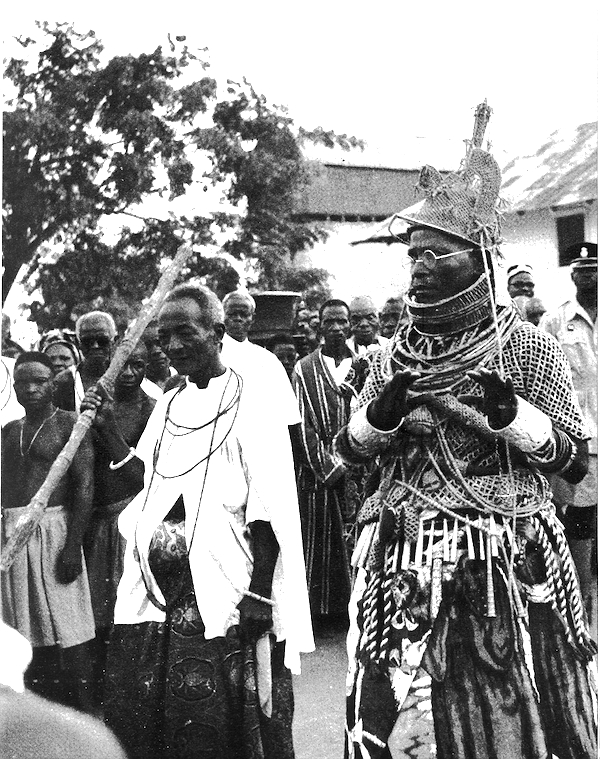
foto: R. Bradbury, "Divine kingship in Benin" (Nigeria Magazine 62, 1959), p. 205
| |
Recorded on 19 June 1977 from Éléje Aghá (popularly known as "Nwá Aghá"), a renowned díbì̩a (8‑bit binary oraclist) of the Ńdi̩ Uchè Ú̩rò̩ moiety of Kpóghirikpó village. As mentioned in the byline at the end of the story, he preferred to be greeted by his díbì̩a name, Òjé‑là mmú̩ó̩ 'The one who goes to the ancestors and then returns back [to the visible world]'.
This widespread myth explains a ritual prescribed by the díbì̩a to the postpartum mother and which is then obligatorily repeated by the child in the mother's presence at the start of adolescent initiation — in both cases arguably to avert the child's death before the 'debt' of procreation has been repaid to the ancestors. Such reproductive failure defines the ò̩gbá‑ǹje complex of reincarnation belief (cf. Manfredi (1997) and references therein; the same text is also transcribed on pp. 343‑48 of my dissertation). The preventive ritual in both instances applies the sympathetic magic of stomping to bits an old bathing gourd corresponding to the physical appearance of the ò̩gbá‑ǹje beings encountered in the farm by the childless woman of the myth, and also for good measure matching the narrative context in which the ò̩gba‑ǹje child's taboo was fatally broken by being called a mere gourd and forced to prepare its own bathing water.
Immediately before performing this text, the same speaker had opened the recording session with Àkó̩ nà míní 'Intelligence in water' (runtime 1:34) which can be heard here.
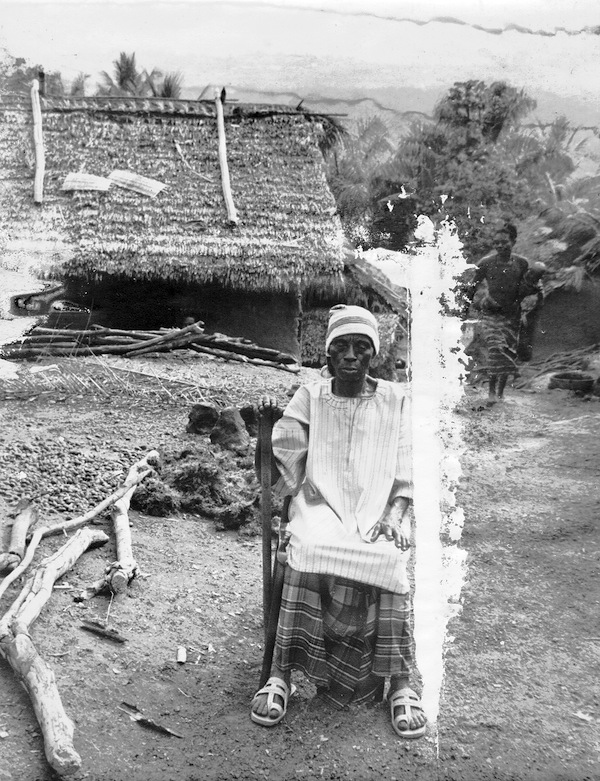
foto: V. Manfredi
| |
Recorded August 1977 in company of "Ígwé" B. Àku̩ńné (Ò̩di̩nani̩ Museum, Àgbádaàna Nri) at the request of Prof. M. Ó̩nwu̩ejìó̩gwù̩ (University of Benin, Benin City) and roughly transcribed/translated as the appendix of this manuscript.
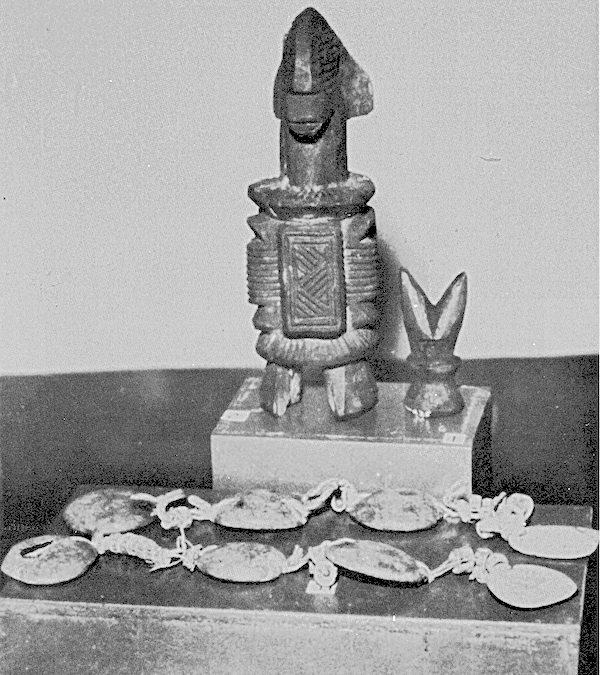
Ígwè, G. [1999]. Ìgbo-English Dictionary. University Press Ltd., Ìbàdàn.
Ó̩nwu̩ejìó̩gwù̩ ["Onwuejeogwu"], M. [1981]. An Ìgbo Civilization; Ǹri kingdom & hegemony. Ethnographica, London for Ethiope, Benin-City.
———[1997]. Áfa Symbolism & Phenomenology in Ǹri Kingdom & Hegemony; an African philosophy of social action. Ethiope, Benin-City.
Williamson, K. [1972]. Ìgbo-English Dictionary, based on the Ò̩ni̩cha ["Onitsha"] dialect. Ethiope, Benin-City. The manuscript of the 1984, 2nd edition (lost by the publisher) has been recovered posthumously and posted online.
| |
Edited composite of recordings made in mid‑1977 led by È̩bú Èdió̩n, an ògbú‑èbulu 'ram‑killer' (herbalist chief) of Àli ̩‑Írèn, Àli̩‑Ísìmíè̩n, Ágbò̩. The performance reconstructs excerpts of the initiation play (égu ò̩mu̩mu̩) originally composed by È̩bú for the coming‑out of his age‑grade circa 1920 — hence his situational appellation of ónye ezè égú ('maestro di cappella'). For the microphone this time around, È̩bú convened a reunion in front of his house. The loud and joyous show attracted a boisterous crowd, audible in the background. No costume or choreography was attempted, all focus being on the counterpoint of bells and chorus with È̩bú's lead vocals and his strenuous obbligatos on è̩kpi ̩ri ̩ — the transverse trumpet carved from an antelope horn, visible in his right hand below. È̩bú's prose introduction to this music, recounting the journey of "Òkórò" (runtime 2:24), transcribed as exx. (5) ‑ (10) on pp. 43f. of my dissertation, can be heard here.
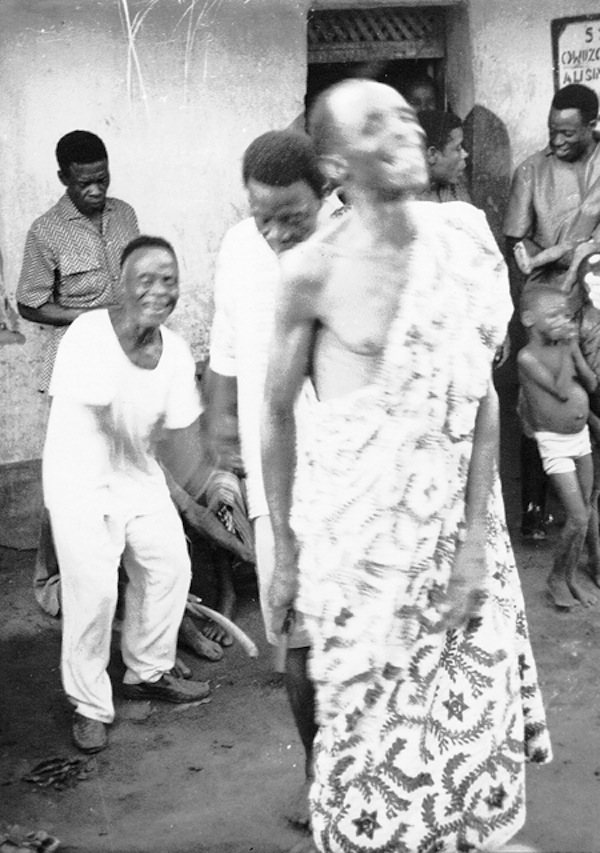
foto: A. Birsh
| |
Ecstatic, tarantella‑like possessional shamanic dance, psychotropaically induced by kái̩n‑kai̩n¹ and by specific rhythms of a double‑barrelled, two‑toned hand‑drum (itself also called è̩ge̩di ) whose membrane is the skin of the puff‑adder.²
Recorded in March 1981 from an ensemble led by díbiè̩ (oracular herbalist) Ńmó̩mà ('The ancestors know') in the house of Àgwó̩basìmí in Àhi̩ma, Àli̩‑Ísìmíè̩n, Ágbò̩. Excluding one song close to the end — for which I forgot to release the pause button of the tape deck — the live sequence is:
È̩nyi̩ abyá — 'We have come/here we are'
Òrise̩, ní̩ è̩nyí̩ me — 'Spirit, work for us'
Òrogodó — '[name of the sacred stream that flows through Ágbò̩]' ³
É̩we̩ ré̩ dibiè̩, é̩we̩ré̩ Ò̩jo̩bu̩ — 'An oraclist is fortunate, and so is the chief of the oraclists'
Ónye rí̩ olò̩ kari̩ ónye ugbó mma — 'Someone who stays at home (to work) is better off than a farmer'
Ówe̩
Nwù̩ye̩n nwu̩ye̩n, égu ùdele — 'The vulture's dance is low and wobbly'
Ó̩ wú̩n ya mè nwá e̩ — 'He's the one who did [i.e. caused problems for] himself'
Ègbé

foto: V. Manfredi
Footnotes
1. This indigenous firewater was called "illicit gin" and "unrecorded alcohol" by the colonial regime, because its production dented British gin profits and tax revenues after 1929, cf. S. Heap, The Liquor Trade & the Nigerian Economy, 1880‑1939 (dissertation, Ìbàdàn University, 2005) summarized in " 'Those that are cooking the gins' ; the business of ògógóró in Nigeria during the 1930s" (Contemporary Drug Problems 35 [2008], 573‑609). For this reason still today, kái̩n‑kai̩n noticeably shares some of the antiauthoritarian élan of the 1929‑30 intifāda against "Lugardism" (A. Áfiìgbo, The Warrant Chiefs; indirect rule in southeastern Nigeria, 1891‑1929, Longman, London 1972, pp. 207‑48) in which state efforts to control palm produce and peasant labor‑time were riotously resisted, and many colonial quislings (the infamous "warrant chiefs") lynched or otherwise deposed. By extension, even humble (spontaneously fermemted) palmwine eventually tapped into the anticolonial lustre and countercultural frisson of its moonshine derivative, as evoked in the poetic output of the Palmwine Drinkerds Club.
2. In Ágbò̩ this snake is called é̩ju̩ àli̩, literally 'coiled head‑pad (é̩ju̩) of the ground', cf. G. Ígwè, Ìgbo-English Dictionary (1985/1999, University Press Limited, Ìbàdàn) p. 33f.
3. Another "Òrogodó" (runtime 0:45), recorded in Ògbe Ńmù̩ Déin on 9 January 1982, can be heard here.
| |
Kó̩ládé contributed to A. Euba, Yorùbá Drumming, the dùndún tradition (Bayreuth, 1990, p. 463).
In the first minute of tape, Susanne Wenger asks the drummers to accompany the singers in moderation.
Note that the first two syllables were truncated from the tape. Transcription.
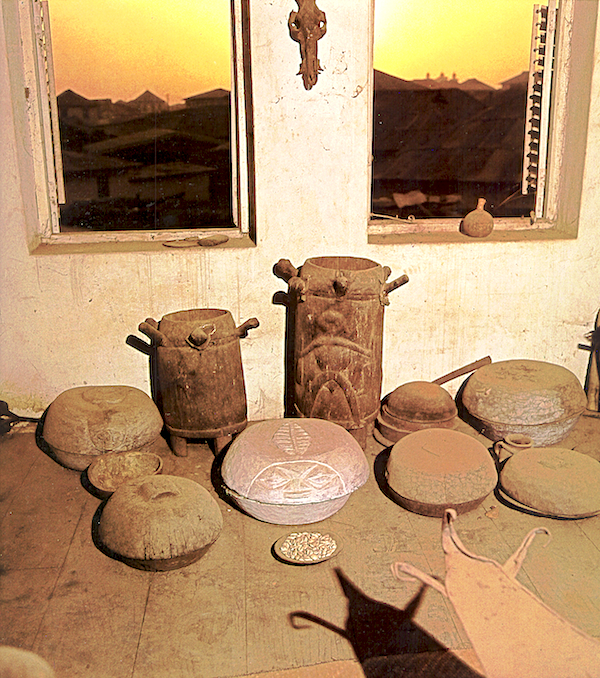
foto: G. Chesi & S. Wenger, A Life with the Gods in their Yorùbá Homeland (Perlinger, Wörgl 1983), p. 31
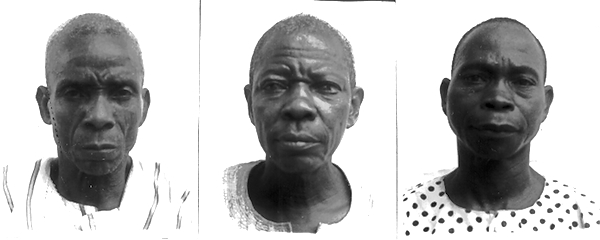

| |
last updated 21 September 2016
|
return to home page
|